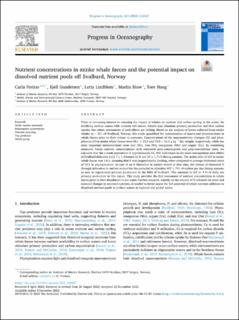| dc.description.abstract | There is increasing interest in assessing the impact of whales on nutrient and carbon cycling in the ocean. By fertilising surface waters with nutrient-rich faeces, whales may stimulate primary production and thus carbon uptake, but robust assessments of such effects are lacking. Based on the analysis of faeces collected from minke whales (n = 31) off Svalbard, Norway, this study quantified the concentration of macro and micronutrients in whale faeces prior to their release in seawater. Concentrations of the macronutrients nitrogen (N) and phosphorous (P) in minke whale faeces were 50.1 ± 10.3 and 70.9 ± 12.1 g kg−1 dry weight, respectively, while the most important micronutrients were zinc (Zn), iron (Fe), manganese (Mn) and copper (Cu). By combining measured faecal nutrient concentrations with estimated prey-consumption and prey-assimilation rates, we calculate that the current population of approximately 15, 000 individuals in the small management area (SMA) of Svalbard defecates daily 7 ± 1.4 tonnes (t) N and 10 ± 1.7 t P during summer. The molar ratio of N:P in minke whale faeces was 1.6:1, meaning that N was proportionally limiting, when compared to average elemental ratios of 16:1 in phytoplankton. In case of no N limitation in surface waters at that time, the release of elemental P through defecation in surface waters has the potential to stimulate 407 ± 70 t of carbon per day during summer as new or regenerated primary production in the SMA of Svalbard. This amounts to 0.2 to 4 % of daily net primary production in this region. This study provides the first assessment of nutrient concentration in whale faeces prior to their dissolution in sea water. Further research, namely on the amount of N released via urine and seasonal changes in excreted nutrients, is needed to better assess the full potential of whale nutrient additions to dissolved nutrient pools in surface waters at regional and global scales. | en_US |
